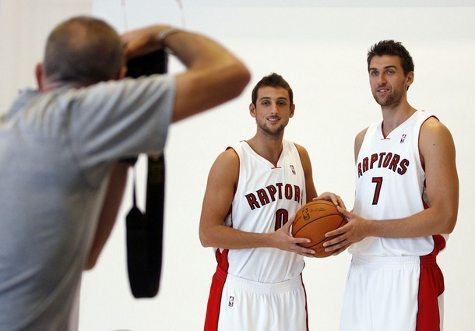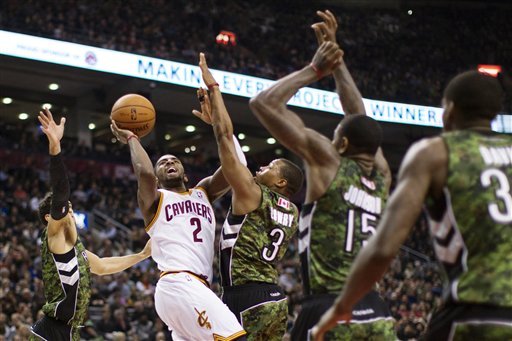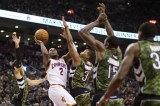
This series of trade reviews, like all good things in life, has come to an end.
Alabi was touted as a possible first rounder before falling out of the top 30. Nabbing him at #50 was considered a steal on draft day, but the latest evidence suggests he’s anything but. Reports this summer have him getting stronger, more confident, and more agile, so it’s best to delay the verdict on this trade till a later date. Judging by what we’ve seen of Alabi so far, he’s been disappointing. In the D-League, where he’s supposed to impose, if not dominate, he looked rather uninterested and had no-name players get the better of him. He’s had three stints down there, and every time he’s come up to the big club, he’s looked the same.
Grade: B-
Team impact: None.
Saying that Bryan Colangelo should have traded Chris Bosh at the deadline or in the previous summer (instead of pairing him with Turkoglu) is not revisionist history. It was an option that Colangelo ignored in the hopes that Bosh would sign an extension. The team sucked, the plan backfired, and Bosh was lost for nothing. Yes, for nothing. Nine million of the TPE will be unused, and that was the main selling point at the time of the trade. One of the two first round picks was already the Raptors’ (from the O’Neal deal), and seeing how Miami will be very good for the foreseeable future, the other pick will be between 27-30. Even at the deadline when it became increasingly apparent that Bosh was going to leave, Colangelo couldn’t trade him and he should be held accountable for that, it’s a main reason we haven’t received a proper asset for Bosh. The perception when Vince Carter was traded was that he was on the decline, and yet Babcock managed to get expiring contracts and two first rounders for him (sure, it got wasted on Joey Graham and the other was traded), setting the table for Colangelo. Surely, we’re expected to hold Colangelo to higher standards than Babcock.
Grade: D
Team impact: Negative.
Ignore the unfortunate signing of Hedo Turkoglu for a second, this trade in a vaccuum is probably one of the best trades the Raptors have ever pulled. This is what I wrote on the day of the trade: “The total savings for the Raptors is $29.3M, but more importantly, we got rid of a player that was just not a good fit. His defense was bad, his offense was extremely perimeter oriented, his attitude was poor and his contract was terrible. It doesn’t matter if Barbosa comes in and rides the pine behind Marcus Banks for 82 games, this is still a good deal!””
Grade: A
Team impact: Very positive.
Anderson was a good find by Colangelo and was fitting in well as a limited-minutes player; I was a little sad to see him go, I’d much rather have a guy like that than Alexis Ajinca. In his brief time here, he played hard, left an impression and I remember him giving Amare Stoudemire a killer elbow.
Grade: B
Team impact: Very slightly positive.
Ouch. The Raptors gave up on Belinelli after one season! This is a lot like my infatuation with Toronto FC, always wanted a football team in Toronto but when I finally got to see one up-close, realized how terrible the quality was. If Julian Wright had a jumper and had a lower qualifying offer, I’d give this a B. Belinelli wasn’t exactly a bad player, he was being asked to be a scorer off the bench in the vein of Mike Miller or O.J Mayo, problem was that he’s not that good. He’s a point-forwardish (I know he’s only 6’5″) role player whose specialty is spot-up shooting, in Toronto he was throwing up off-balance one-legged fadeaways and when one of them finally went in, Leo Rautins ate it up. I’ll say the team impact was negative because Julian Wright’s defense was never put to use consistently, and the Raptors missed the three-point shooting Belinelli brought.
Grade: C-
Team impact: Negative.
This depends on how good/bad Jerryd Bayless turns out to be. Whatever happens there, he can’t be any worse than Jarrett Jack as he’s essentially the same player with slightly better defense. Some expiring contracts in this one as well which evened things out, and I got to see my dream come true when Peja suited up for the Raptors. David Anderson was missed, as I already said, would rather have him than Alexis.
Grade: B
Team impact: Positive.
This trade didn’t improve or make the team any worse, what it did is make it more annoying, which to me is a negative.
Grade: Boring.
Team impact: Slightly negative
We could have had local boy Cory Joseph who was drafted by the Spurs. If it wasn’t the Spurs that drafted him I’d be OK, but it was the damn Spurs who know what they’re doing late in the round. I have to say it’s had a positive impact, though, we’ve been able to scrutinize and evaluate a player who was considered to have potential at one time. All this on the cheap in a development year, can’t go wrong with that. Unless of course, Joseph turns out to be a find.
Grade: C+
Team impact: Slightly positive.
Believe it or not, I filled three days of summer with this nonsense. Here’s the first and second part.




